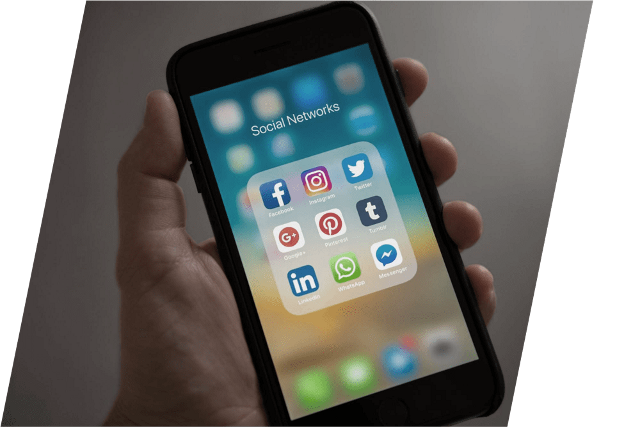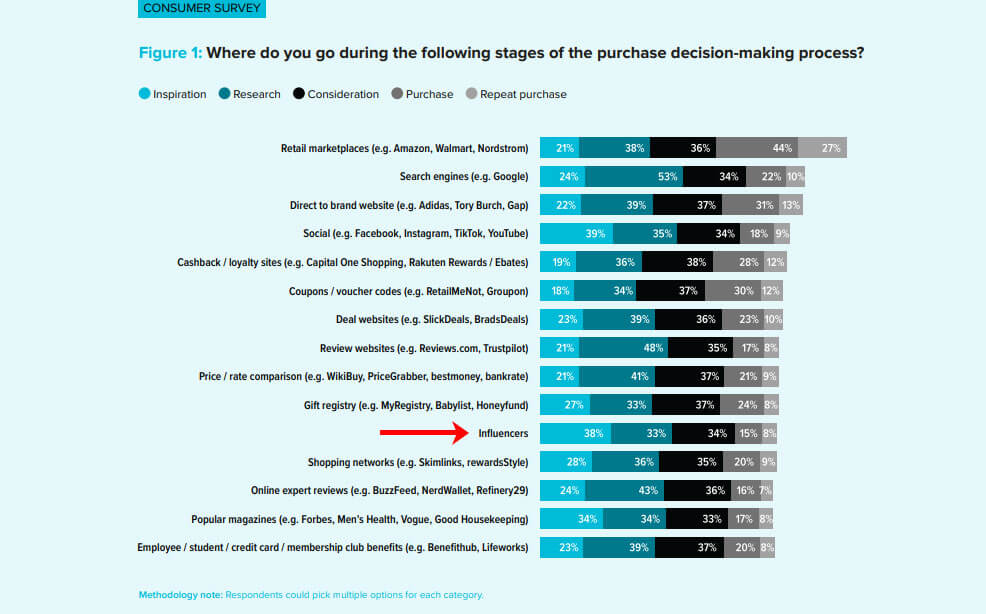Influencer Marketing Strategy: The Definitive Guide
Ready to use influencer marketing to its fullest potential? In this guide, we’ll walk you through how to create a solid influencer marketing marketing strategy.

Influencer marketing has been steadily growing in popularity and is now an essential part of digital marketing strategies. In fact, according to research by Gen3 Marketing, 54% of surveyed organizations plan on increasing their influencer marketing budget over the next 12 months.
If you want to drive exponential results and a high ROI with influencer marketing, you need an influencer marketing strategy.
In this guide, we’ll break down exactly what an influencer marketing strategy is, why it’s so important, and how you can build one in your business:
- What is an Influencer Marketing Strategy?
- Why is an Influencer Marketing Strategy Important?
- Types of Influencers
- Benefits of an Influencer Marketing Strategy
- 11 Steps to Build an Influencer Marketing Strategy
What Is an Influencer Marketing Strategy?
Influencer marketing is the process of leveraging a person’s or brand’s audience for the benefit of your brand. That person may be someone in your organization with a great personal brand or a third-party influencer who has a large following or notable reputation – think bloggers, podcasters, or social media influencers, for instance. Or it could be a publication with a large audience. You work with this person or brand to promote your products or services.
An influencer marketing strategy is a well-defined plan that lays out how you will use influencer marketing to succeed as a brand. It guides you through the process of putting together influencer marketing campaigns, as well as the tactics needed to make it happen.
An influencer marketing strategy serves as a roadmap for your brand. It guides you from start to finish with your influencer marketing efforts. It tells you where you’re going and how you’re going to get there.
Why Is an Influencer Marketing Strategy Important?
Without an influencer marketing strategy, your influencer marketing efforts will be haphazard at best. Your campaigns will be directionless, your partnerships will be anemic, and you’ll most likely end up spinning your wheels, putting in a lot of effort with little to show for it.
Additionally, without an influencer marketing strategy, you won’t know whether your influencer programs are successful. You won’t know whether you met your goals and moved the needle in the way you hoped. A key part of an influencer marketing strategy is setting clear goals, KPIs, and key metrics that help you determine whether your influencer marketing efforts are successful.
A well-defined influencer strategy helps you know what to do and when to do it. It establishes clear goals and objectives, so that you can measure success and adjust accordingly. This makes it easier to hit your targets and make the most out of influencer marketing.

Types of Influencers
There are four types of influencers. While the numbers may vary depending on who you ask, they can generally be broken down in the following way:
Nano-influencers
Nano-influencers are individuals who have an audience in the range of 1,000 – 10,000 followers. While they have a smaller follower count, their audiences are usually highly engaged with the influencer and respond to recommendations from the influencer. These influencers are usually less expensive than those with larger audiences.
Working with nano-influencers can help your brand target highly specific demographics without spending an exorbitant amount of money. If you’re targeting a niche community, nano-influencers can be an excellent way to go.
Micro-influencers
Micro-influencers typically have an audience in the range of 10,000 – 100,000. Like nano-influencers, micro-influencers often have an engaged audience that eagerly consumes the content they create and responds well to influencer recommendations.
While they are more expensive to work with than nano-influencers, micro-influencers still deliver plenty of bang for your buck. With a 60% higher engagement rate than macro-influencers, micro-influencers can help you drive brand awareness and conversions while still being cost-effective.
Macro-influencers
Macro-influencers are those with an audience in the range of 100,000 – 1 million. These influencers have a large reach and can draw attention to your product or service quickly. They are well-established within their space/industry and are usually considered to be thought-leaders.
Maco-influencers give you access to a large audience that is still somewhat targeted when compared to mega-influencers. Of course, with a larger audience comes a higher price. But, if you can afford to work with a mega-influencer, it can drive a significant amount of brand awareness and conversions.
Mega-influencers
A mega-influencer has an audience of 1 million or more. These are the celebrity influencers. These influencers have a massive reach and their endorsements can help spread the word about your brand quickly. They are highly sought after by brands and can command higher prices than other types of influencers.
However, it’s important to keep in mind that mega-influencers tend to have less targeted audiences than micro-and macro-influencers. Unless your product or service has wide appeal, you may not get the same Return on Investment (ROI) as you would from working with micro-or macro-influencers.
Want to drive exponential returns with influencer marketing?
Benefits of an Influencer Marketing Strategy
There are a number of key benefits that come with an influencer marketing strategy.
Reach New Audiences
Influencer marketing gives you access to audiences you would never be able to reach otherwise. It allows you to tap into the personal networks and audiences of influencers and reach potential customers who would otherwise be completely unaware of your brand.
According to MorningConsult, 50% of Millennials trust influencers when it comes to product recommendations. An influencer marketing strategy enables you to connect with sought-after influencers and get your product or service in front of their audience.
Increased Brand Awareness
An influencer marketing strategy enables you to drive brand awareness and build trust. It’s a powerful way to get your message out there and make sure it reaches the right people.
Insights from in-depth affiliate marketing research done by Gen3 Marketing, a whopping 38% of consumers look to influencers for inspiration during the shopping process.

When done correctly, influencer marketing can be a great way to increase brand awareness and visibility. By working with the best influencers who resonate with your target audience, you can create positive sentiment around your brand and raise awareness of your products or services.
Increased Audience Engagement
As we noted earlier, influencers, particularly those with smaller reach, often have very engaged audiences. These audiences look to influencers for inspiration and guidance regarding purchasing decisions.
By leveraging an influencer marketing strategy, you can reach a highly engaged audience and drive more engagement with your brand. Unlike much traditional advertising, which is often ignored by audiences, influencer marketing allows you to capture people’s attention and engage with them on a more personal level.
Meaningful Relationships With Influencers
Finally, an influencer marketing strategy allows you to develop meaningful relationships with influencers. The reality is that influencer marketing is most effective when there is a strong relationship between the brand and the influencer. When an influencer truly believes in a product or service, they can be more authentic when they promote it.
Authenticity matters a lot to audiences. If they sense that an influencer doesn’t really care about a product or service, they’re much less likely to purchase that product or service. Building strong relationships with influencers is key to successful influencer marketing.
When done correctly, influencer marketing can be a great way to increase brand awareness and visibility. By working with the best influencers who resonate with your target audience, you can create positive sentiment around your brand and raise awareness of your products or services.
Increased Audience Engagement
As we noted earlier, influencers, particularly those with smaller reach, often have very engaged audiences. These audiences look to influencers for inspiration and guidance regarding purchasing decisions.
By leveraging an influencer marketing strategy, you can reach a highly engaged audience and drive more engagement with your brand. Unlike much traditional advertising, which is often ignored by audiences, influencer marketing allows you to capture people’s attention and engage with them on a more personal level.
Meaningful Relationships With Influencers
Finally, an influencer marketing strategy allows you to develop meaningful relationships with influencers. The reality is that influencer marketing is most effective when there is a strong relationship between the brand and the influencer. When an influencer truly believes in a product or service, they can be more authentic when they promote it.
Authenticity matters a lot to audiences. If they sense that an influencer doesn’t really care about a product or service, they’re much less likely to purchase that product or service. Building strong relationships with influencers is key to successful influencer marketing.

11 Steps to Build an Influencer Marketing Strategy
Now let’s talk about specific steps involved in building an influencer marketing strategy.
1. Determine Your Goals
The first step in building an effective influencer marketing strategy is determining your goals. Your goals will shape your budget, the influencers you work with, your promotional strategies, your content creation, and more. Your goals will also help you measure the success of your influencer marketing campaigns and identify the steps you need to take in order to achieve that success.
What are you trying to achieve through influencer marketing?
- Build brand awareness?
- Drive more conversions?
- Target a specific audience?
- Drive more leads?
- Increase engagement?
Ensure you are crystal clear regarding what you want to achieve through influencer marketing. A lack of clarity on goals will almost certainly translate into subpar results.
2. Determine KPIs and Key Metrics
Once you’ve specified your overall goals, you need to determine the Key Performance Indicators (KPIs) and key metrics you will use to evaluate your performance. KPIs and metrics will help you measure the success of your influencer marketing campaigns, identify areas for improvement, and track progress toward your goals.
It’s important to choose relevant KPIs that are directly related to what it is you’re trying to achieve. For example, if your goal is to build brand awareness, one metric could be the number of impressions generated across all your influencers’ social media platforms. Or you could track the amount of website traffic to a specific page from social channels, the number of clicks from specific TikTok videos, engagements on Snapchat, etc.
If your goal is to sell more of your new product, maybe you send a free product to your influencer partners, offer their audiences a promo, and then track how many people used the discount code.
No matter what your objectives are, your metrics should be closely tied to your goals and the platforms you’re using.
3. Specify Your Budget
Your budget is going to determine which influencers you work with, the content you create, and the distribution channels you utilize. Think carefully about how you want to allocate your budget. Do you want to work with one larger influencer or multiple smaller influencers?
Bigger isn’t always better when it comes to influencer marketing. Influencers with smaller audiences can get your product or service in front of highly targeted audiences.
The content you create will also be a determining factor in your budget. Generally speaking, video costs more to produce than still photographs. What type of content will resonate most with your audience? Take this into account when determining your budget.
It’s also important to take promotional costs into account when determining your budget. You may want to promote influencer content through paid channels such as Facebook, Instagram, and YouTube. This can add up quickly if you are working with multiple influencers.
4. Clarify Your Audience
Knowing your audience is essential for any type of marketing. But with influencer partnerships, it’s especially important because you are working with specific individuals within a niche audience.
Think about the values and interests of your target audience. What type of content do they like? Who are their favorite influencers? What platforms do they use? Knowing this information will help you find the right influencers to work with.
For example, if you are targeting millennials, you may want to work with Instagram influencers or publications like Buzzfeed. If you’re targeting executives, you may want to collaborate with LinkedIn influencers or publications like Forbes.
It’s also important to clarify your audience’s preferred tone and language. This will help you create content that resonates with them. Additionally, it will make it easier for influencers to work with you if they understand the type of language and tone that resonates with your target audience.
Creating audience personas can be a helpful exercise for clarifying your audience. A persona is a fictional representation of your ideal customer. You can create multiple personas that represent different segments of your target audience.
Ready to generate exponential returns with influencer marketing? Gen3 can help help!
5. Choose a Campaign Type
Once you have clarity on your goals, budget, and audience, you can choose the type of influencer campaign you want to run. Each type of influencer campaign has its own advantages, so think about which one will benefit your brand the most.
You have numerous types of campaigns available to you:
- Sponsored content
- Social media text/photo
- Social media video
- Guest blog posts
- Livestreams
- Giveaways and contests
- Product reviews
- Brand ambassadorships
- Coupons
It’s important to choose a campaign type that will help you reach your goals. For example, if you want to increase brand awareness, social media might be an effective option. After all, according to Gen3 Marketing research, 39% of consumers use social media during the “Inspiration” stage of the buying journey.
If your goal is to drive more conversions, you may want to utilize social proof such as product reviews, as 36% of consumers rely upon expert reviews in the purchase phase of the buying journey.
6. Create Campaign Messaging
The next step in creating an influencer marketing strategy is developing your campaign messaging. This includes the primary talking points of the campaign, calls-to-action, etc.
To be clear, this is not a word-for-word script that influencers must include in their content. Rather, these should be broad strokes that still leave room for the influencer to be creative and speak in an authentic way to their audience.
If your campaign messaging is too rigid, it will make the influencer sound inauthentic and the content they create won’t resonate with their audience. Make it clear what you want the influencer to communicate without dictating what they must say word-for-word.
Your campaign messaging should also contain your brand values and mission. This helps ensure the content remains in line with your brand’s overall message and doesn’t veer off track.

7. Find Relevant Influencers
After you know what type of campaign you want to run, it’s time for outreach! Identify relevant influencers to work with. You want to work with influencers who understand your audience, your brand, and the type of content you’re promoting.
How can you identify relevant influencers? Several ways.
First, search popular hashtags and find content creators that are getting significant engagement around those hashtags. This will help you find influencers that have an existing relationship with your target audience.
Marketing tools like BuzzSumo also make it easy to find influencers in your industry. You can simply type in a keyword and see which people are sharing content about that subject. Those with sizable audiences represent potential influencers to collaborate with.
If you want to partner with a publication to get your brand in front of their audience, consider partnering with an agency like Gen3 Marketing. Gen3 has some of the strongest and deepest publisher relationships in the industry. Influencer marketing agencies like us can match you with publishers that have audiences most likely to engage with your content.
Another option is to use an influencer marketing platform like Creator.co. Creator.co has a massive database of influencers across multiple platforms and can help you identify relevant influencers.
When getting started with influencer marketing, it can be helpful to start with a single platform and then expand from there. Focus on creating a strategy that works for your brand and build relationships with influencers.
8. Work with Influencers to Create Content
Once you’ve identified and partnered with specific influencers, you can begin working with them to create content. This content should be tailored specifically to the influencer’s audience and speak in ways that resonate with that audience.
The best content provides value for the influencer’s audience. Yes, it’s promoting your product or service, but it should provide value first and foremost. It should show the influencer’s audience that you provide value and that your product or service is worth considering.
The content you create should fit naturally on the influencer’s primary platform. For example, if you’re working with an Instagram influencer, you should produce photos or videos that feel natural to the platform. If you’re partnering with a major publication, you should focus on creating high-quality written pieces that mirror what is normally published on the site.
9. Promote Influencer Content
Content marketing is so important. Don’t rely solely on an influencer to promote the content created. Your own channels, including social media and email, should be used to promote the content as well.
For example, if your product is included in a product roundup in Vogue, promote that roundup via social media, email, etc. Your goal is to get the content in front of as many people as possible.
You may also want to invest some advertising dollars in promoting the content created by you and the influencer. This can help you reach a wider audience and get more engagement.
10. Track Your Results
It’s essential to track the results of your influencer campaigns. If you don’t carefully track the results, you can’t know whether your efforts were successful.
The KPIs and key metrics you established at the beginning of your campaign should be used to measure the success of your strategy. Don’t settle for fuzzy numbers or a lack of clarity. Track the results down to the detail, and use those numbers to decide if your influencer campaign was successful.
By tracking the results of your influencer campaigns, you can better understand what works and what doesn’t work when it comes to influencer marketing. This will help you refine and optimize future strategies to ensure
11. Optimize Your Campaigns
After measuring the results of a campaign, it’s important to review what worked and what didn’t. Make adjustments to your strategies accordingly, so you can optimize future campaigns for even better results.
Use the data you’ve collected to find new influencers that might be a good fit for your brand. You should also look at ways to maximize engagement and ROI from existing influencers.
Finally, review the content created by influencers and adjust your strategy if necessary. Look for ways to make the content more engaging and compelling. This can help maximize engagement and ensure that your influencer campaigns are as successful as possible.

Conclusion
Influencer marketing is an effective marketing strategy when done correctly. It enables you to reach new audiences, grow brand awareness, increase conversion rates, and ultimately drive more sales.
In order to succeed with influencer marketing, you need a well-defined influencer marketing strategy. A strategy will guide your efforts each step of the way, ensuring you stay on track and get the highest ROI possible.
If you need help with your influencer marketing, Gen3 would love to help. With the most experience of any affiliate marketing agency and the deepest publisher relationships in the industry, Gen3 knows how to drive exponential returns with influencer marketing.
Ready to raise your ROAS?
More Blogs
B2B Affiliate Marketing: An Introduction
Affiliate isn’t just for direct-to-consumer brands. This guide explains how B2B companies are using the channel to grow smarter—not just faster.Affiliate marketing is a performance-based channel built around relationships between a brand and its affiliates (often...
Active vs Passive Rewards Programs: What Brands Need to Know
Learn about “click-to-activate” and “always-on” rewards programs. Find out what they do to amplify and accelerate affiliate program success.When I think about rewards programs, I’m brought back to shopping with my mother in the ‘90s. She had a wallet full of...
Partnership Marketing: The Ultimate Guide
Partnership marketing is reshaping how brands scale reach, trust, and revenue. In this guide, we break down why it works, how to leverage it, and how to get it right.Partnership marketing has been a tactic since the rise of the internet and ecommerce in the late...

 By
By 

